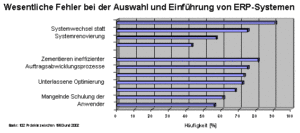by Dr.-Ing. Dipl.-Wirt.-Ing. G.-A. Kemmner
As already mentioned in the previous article, the Enterprise Resource Planning System embodies a program concept that ensures the business process without interrupting the value chain and the flow of data and information in order to efficiently plan, control and evaluate operational processes.
Nowadays, a company that has outgrown the garage stage can hardly manage without an ERP system. But choosing the right system is not as easy as choosing the right word processor: there are currently around 150 ERP system providers with more or less comprehensive systems on the German-speaking market. What’s more, implementing the system into day-to-day business operations is not something that can be done at the weekend, but requires months of careful preparation.
But which employee in a medium-sized company is experienced in the selection and implementation of ERP systems? In many cases, only large corporations can afford such personnel. SMEs, on the other hand, need to consult external service providers – both for the selection and implementation of the ERP system. Otherwise, they run the risk of making at least one of the mistakes that we repeatedly encounter in our consulting projects and firefighting operations.
When selecting a system, for example, it doesn’t help much to rely solely on the market leaders having the best solution. Even if the market is clearly dominated by SAP in large-scale industry, the cake is far from being shared out in the SME sector. Although SAP is trying to place its R/3 or mySAP.com software product here via SME partners, it is encountering many reservations among SMEs and is obviously not making much headway. SAP’s acquisition of the Israeli system provider TopManage should also be seen in this context. The aim is to make faster progress with a separate SME package. A second software giant – with a stronger presence in the SME sector than SAP – has chosen the field of ERP systems as a further area of business: Microsoft. With the acquisition of the Danish ERP system provider Navision, Microsoft positioned its troops in Europe against SAP. But who would want to predict today that Microsoft will be able to continue its success story in this segment?
The only thing that is certain is that the requirements in the SME sector are and will remain so complex that it is always necessary to take a close look in order to avoid backing the wrong horse. The statistics show that this is not so simple: even if no valid figures are known, there is a public consensus that the original targets were not achieved in 50% of system launches. In 40% of all system launches, the originally planned cost budget is significantly exceeded. And we can only endorse that.
In practically all projects over the past 10 years, we have repeatedly encountered the same mistakes and incorrect cost/benefit considerations when selecting and implementing ERP systems, which are listed in the diagram opposite.
In our experience, the only reliable way to search the ERP system market for the right system for your own company is still a two-stage approach. In a pre-selection phase, suitable software packages must be pre-selected by means of a functional comparison of the ERP systems. The two to three best of the filtered-out systems are then scrutinized in detail in a final selection.

Due to the large number of systems on the market, a software database should be used for the pre-selection phase, which enables the functional performance features of the ERP system to be evaluated comparatively. We use the IT Matchmaker database for this purpose. In our experience, this constantly updated database provides the most up-to-date overview of the relevant ERP and PPS systems currently available on the market.
Due to the large number of stored criteria, it is differentiated in the selection, but complex in the interpretation of the requirement criteria and can therefore only be handled by experienced experts.
If you are about to decide on a new ERP system, you should consider the following 10 tips for ERP implementation:
- Think about whether a new IT system is really necessary!
- Proceed systematically: First simplify, then select an ERP system, then introduce and train, and finally optimize.
- Let the experts design and radically simplify your order processing!
- Choose your ERP system to suit your organization and not by board decision!
- Select your system according to business criteria and not according to the number of functions available.
- Reduce implementation costs and risks by selecting less complex systems and limiting yourself to the essential modules and functions in an initial operating stage.
- Involve employees in the ERP implementation.
- Make sure you have enough qualified application consultants!
- First you train, train, train, then you test, test, test!
- Don’t forget to optimize after the launch!

